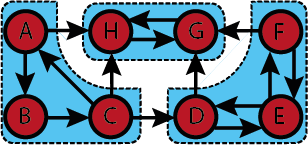Strongly connected components: Difference between revisions
No edit summary |
No edit summary |
||
| Line 10: | Line 10: | ||
A set of sets of nodes. Each set of nodes contains exactly the nodes of one SCC. The correspndence between SCC and sets of nodes is one-to-one. | A set of sets of nodes. Each set of nodes contains exactly the nodes of one SCC. The correspndence between SCC and sets of nodes is one-to-one. | ||
== Pseudocode == | |||
====STRONGLY-CONNECTED-COMPONENTS(''D'')==== | |||
<code> | |||
STRONGLY-CONNECTED-COMPONENTS(''D'') | |||
1 call '''DFS'''(''D'') to compute finishing times ''f''[v] for each vertex ''v'' ∈ ''V'' | |||
2 compute ''D''<sup>''T''</sup> (w.r.t. step 3) | |||
3 call '''DFS'''(''D''<sup>''T''</sup>), but in the main loop of '''DFS''', consider the vertices in order of decreasing ''f''[v] as computed in step 1 | |||
4 output the vertices of each tree in the '''DFS''' forest of step 3 as a separate strongly connected component | |||
</code> | |||
== Known algorithms == | == Known algorithms == | ||
# [[Kosaraju]] | # [[Kosaraju]] | ||
Revision as of 15:51, 23 October 2014
Definition
Let [math]\displaystyle{ G=(V,A) }[/math] be a directed graph. Consider the following equivalence relation on the nodes: [math]\displaystyle{ v\in V }[/math] and [math]\displaystyle{ w\in V }[/math] are equivalent if, and only if, there is a path fmo [math]\displaystyle{ v }[/math] to [math]\displaystyle{ w }[/math] and a path from [math]\displaystyle{ w }[/math] to [math]\displaystyle{ v }[/math] in [math]\displaystyle{ G }[/math]. The equivalence classes are called the strongly connected components (SCC) of [math]\displaystyle{ G }[/math].
Input
A directed graph [math]\displaystyle{ G=(V,A) }[/math].
Output
A set of sets of nodes. Each set of nodes contains exactly the nodes of one SCC. The correspndence between SCC and sets of nodes is one-to-one.
Pseudocode
STRONGLY-CONNECTED-COMPONENTS(D)
STRONGLY-CONNECTED-COMPONENTS(D)
1 call DFS(D) to compute finishing times f[v] for each vertex v ∈ V
2 compute DT (w.r.t. step 3)
3 call DFS(DT), but in the main loop of DFS, consider the vertices in order of decreasing f[v] as computed in step 1
4 output the vertices of each tree in the DFS forest of step 3 as a separate strongly connected component
